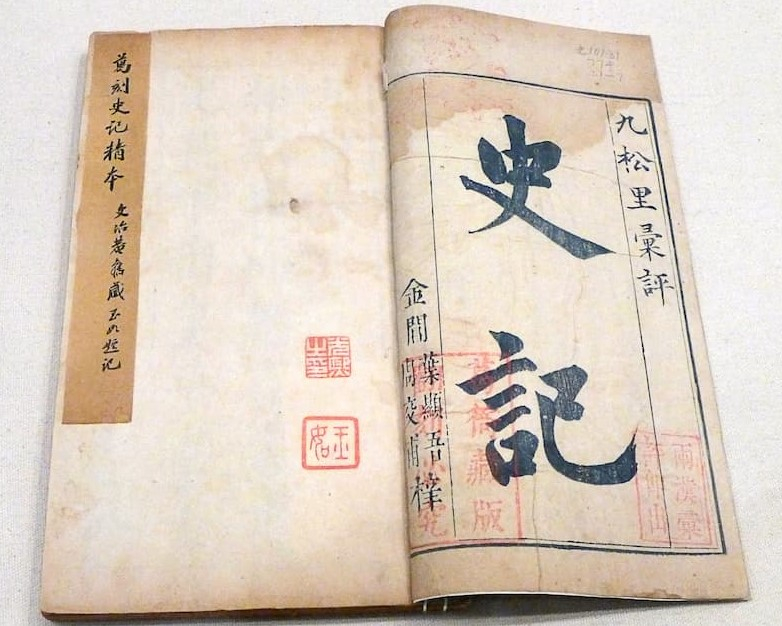
Sima Qian and Records of the Historian
Splendid
Chi Culture
Topic
Sima Qian and Records of the Historian
Sima Qian (ca. 145–ca. 90 BCE), courtesy name Zichang, was from what is now Hancheng, Shaanxi province. He was a great historian, writer, and thinker of the Western Han dynasty (206 BCE–24 CE). His work Shi ji, or Records of the Historian, is the first book to present Chinese history in a series of biographies. Modern Chinese scholar and writer Lu Xun (1881–1936) said, “Shi ji is a historian’s poetic masterpiece, a ‘Li sao’ without the rhyme.” (“Li sao” is a famous Chinese poem dating from the Warring States period, 475–221 BCE).
Sima Qian was born into a family of historians; he was a precocious child who was fond of scholarship. When he was twenty years old, Sima Qian began to travel around the realm. In his middle years, he was sent on an expedition to area south of Ba and Shu (modern Sichuan). When he was thirty-five, Sima Qian followed his father’s wishes and assumed the role of grand scribe (a position responsible for historical records and the calendar) and wholeheartedly devoted himself to writing history. In 99 BCE, Emperor Wu of the Han (r. 141–87 BCE) ordered general Li Ling (d. 74 BCE) to lead a campaign against the Xiongnu in the north; the battle did not go well and Li Ling surrendered. Emperor Wu was furious and while all of the government officials attributed the defeat to Li Ling, Sima Qian was the only person to defend him. At first, the emperor accepted Sima Qian’s opinion. However, when rumors began circulating saying that Li Ling was helping to train Xiongnu troops, the emperor had every member of the general’s family executed and Sima Qian castrated. Castration was a great humiliation causing him to be despised by family and friends and bringing shame to his clan. Depressed, Sima Qian thought about committing suicide but, for the sake of completing his history, chose to live on with the ignominy. Sima Qian finished Shi ji in 91 BCE and died the next year.
Sima Qian lived at a time when the Han dynasty was prosperous and strong. The flourishing cultural climate provided the right conditions for Shi ji to emerge. During his life, Sima Qian made three important journeys. In his twenties, he traveled to areas along both shores of the Huai River and also into the Central Plain. This experience laid the foundation for Shi ji. Later, as a government officer, he was sent on a westward expedition; during this time, he visited areas of modern Sichuan, Yunnan, and Guizhou provinces and collected material for his history of various ethnic groups. The grandness of the feng and shan sacrifices, where the emperor paid homage to heaven and earth at Mount Tai, helped Sima Qian write “Jinshang benji” (Basic annals of the current emperor) and “Fengshan shu” (Monograph on the feng and shan sacrifices). Sima Qian’s father Sima Tan (165–110 BCE), his teachers Dong Zhongshu (179–104 BCE) and Kong An’guo (ca. 156–ca. 74 BCE), and the Chunqiu (Spring and autumn annals) of Confucius (551–479 BCE), all influenced him significantly. Sima Qian’s father strengthened his son’s resolve to be a historian when, shedding tears on his deathbed, he asked his son to serve as grand scribe and to carry on the work he had started. Profoundly moved, Sima Qian promised that he would carry on this important work. His teachers Dong Zhongshu and Kong An’guo imparted to him effective methods for writing history. Dong Zhongshu was a Western Han philosopher and a master of New Text Ruism. (New Text Ruism was based on those Ruist classics recompiled in the early Han dynasty by Ruists who survived persecution during the Qin dynasty.) Sima Qian adopted some of Dong Zhongshu’s important ideas. He was against tyranny and supported the principle of zunwang rangyi (literally “revere the king, expel the barbarians.” It was a Ruist political philosophy). Sima Qian’s standards of valuing historical figures also followed Dong Zhongshu; he honored people who were modest. Kong An’guo was a twelfth generation descendant of Confucius and was the founder of Old Text Ruism (a school of thought focusing on some versions of the Five Classics discovered during the Han dynasty, written in archaic characters and supposedly produced before the burning of the books). Sima Qian was influenced by Kong An’guo and emphasized the importance of using classics when writing history. Sima Qian also adopted Confucius’ technique of writing the Chunqiu, which was to convey lofty principles in subtle words. During the Spring and Autumn period (770–476 BCE), rites and ritual music were abandoned. By compiling and recording two hundred and forty-two years of the state of Lu’s history, Confucius expressed his beliefs about ruling a state and delivered a moral guide to the proper way of living. The Chunqiu is the model for Sima Qian’s Shi ji.
The Shi ji covers the time span from the legendary Yellow Emperor to the reign of Emperor Wu of Han, in the author’s own time. The work comprises about 520,000 characters, and covers the fields of politics, history, astronomy, geography, philosophy, among others. It is a historical work of unprecedented scope and depth and is considered one of the greatest works in Chinese literature. As a history book, its narration centers on people and initiated a new style of presenting history in a series of biographies. Sima Qian initiated the practice of inserting historical judgments using the formulaic phrase: “the Grand Scribe says,” which conferred a sense of vigor and that what followed was a faithful record. As a literary work, it uses exemplary historical events and dramatic plots to portray figures; it is especially skillful in its use of details. Its elegant and concise language with a certain momentum is captured in many famous idioms. The stories were beautifully written and are masterpieces of prose from the Qin and Han and would have a profound influence on the later “eight great prose masters of the Tang and Song.”




